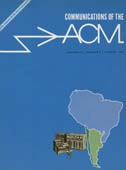August 1969 - Vol. 12 No. 8

Features
Computing capabilities at Argentine and Chilean universities
The author reports on a trip to universities in Argentina and Chile during November 1968, describing university conditions and computing activities. As elsewhere, these universities are experiencing student discontent with the status quo and the solutions they are attempting contrast: Argentina is excluding students from participating in university government; Chile is allowing such participation. University computing service and academic activities are limited. The number of computers is small and so is the capacity, none larger than an IBM 360/40; with some exception, computing science academic programs are rare. This situation is by no means attributable to those responsible for computing developments, who strive for excellence; rather the “system” is hard to overcome. Universities, especially those with strong European traditions, adapt slowly to new academic resources and disciplines; superimposed are the severe technological and economic constraints of the developing nation. Consequently, in the absence of conscious government emphasis on strengthening computing capabilities, future progress may be retarded.
One of the first definition facilities for higher level languages is described. Users of the language can define new operators and/or data types into the MAD language, so that their use appears as if they were predefined. Information is given on how one writes definitions, as well as on much of the motivation behind the form in which definitions are written. Some conclusions are drawn about future definitional facilities.
An ALGOL-based associative language
A high level programming language for large, complex associative structures has been designed and implemented. The underlying data structure has been implemented using a hash-coding technique. The discussion includes a comparison with other work and examples of applications of the language.
Error bounds for periodic quintic splines
Explicit error bounds for periodic quintic spline interpolation are developed. The first (third) derivative of the periodic spline is shown to be a sixth (fourth) order approximation at the mesh points to the first (third) derivative of the function being interpolated.
An algorithm for Filon quadrature
An algorithm for Filon quadrature is described. Considerable attention has been devoted to an analysis of the round-off and truncation errors. The algorithm includes an automatic error control feature.
The teachable language comprehender: a simulation program and theory of language
The Teachable Language Comprehender (TLC) is a program designed to be capable of being taught to “comprehend” English text. When text which the program has not seen before is input to it, it comprehends that text by correctly relating each (explicit or implicit) assertion of the new text to a large memory. This memory is a “semantic network” representing factual assertions about the world.
The program also creates copies of the parts of its memory which have been found to relate to the new text, adapting and combining these copies to represent the meaning of the new text. By this means, the meaning of all text the program successfully comprehends is encoded into the same format as that of the memory. In this form it can be added into the memory.
Both factual assertions for the memory and the capabilities for correctly relating text to the memory's prior content are to be taught to the program as they are needed. TLC presently contains a relatively small number of examples of such assertions and capabilities, but within the system, notations for expressing either of these are provided. Thus the program now corresponds to a general process for comprehending language, and it provides a methodology for adding the additional information this process requires to actually comprehend text of any particular kind.
The memory structure and comprehension process of TLC allow new factual assertions and capabilities for relating text to such stored assertions to generalize automatically. That is, once such an assertion or capability is put into the system, it becomes available to help comprehend a great many other sentences in the future. Thus the addition of a single factual assertion or linguistic capability will often provide a large increment in TLC's effective knowledge of the world and in its overall ability to comprehend text.
The program's strategy is presented as a general theory of
A program for the syntactic analysis of English sentences
A program is described which produces syntactic analyses of English sentences with respect to a transformational grammar. The main features of the analyzer are that it uses only a limited dictionary of English words and that it pursues all analysis paths simultaneously while processing the sentence from left to right.
The form of representation used for the dictionary and the grammar is indicated and an outline account is given of the analysis procedure. Techniques for keeping the size of the analysis record within reasonable limits and for avoiding the need for dynamic application of certain transformational rules are described.
A number of examples of output produced by the program are given. The output includes timing information.



